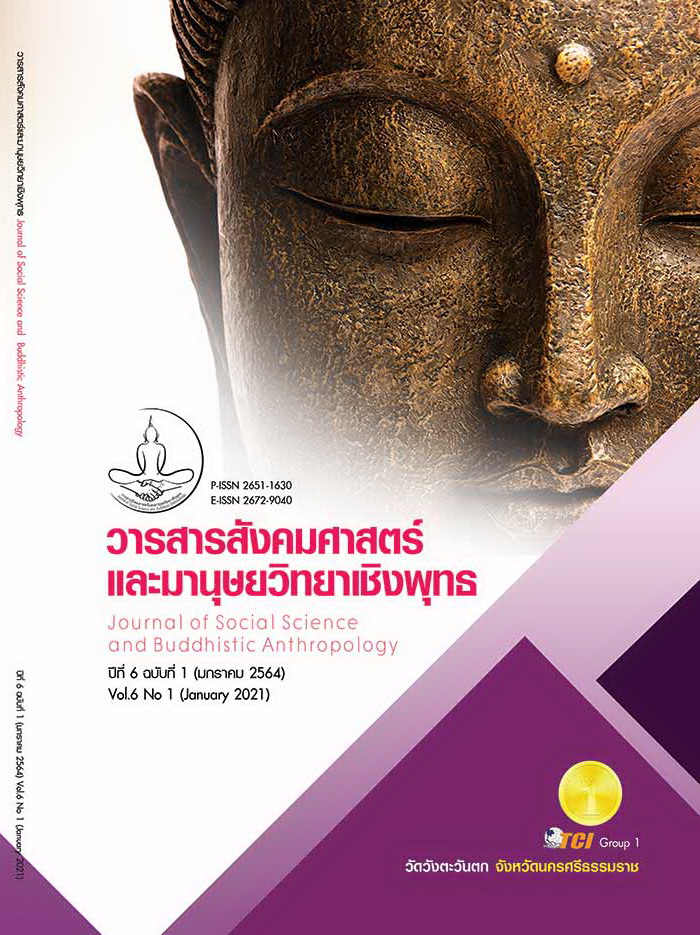SOCIAL MOVEMENT OF THAI WOMEN’S MOVEMENT REFORM FOR WOMEN’S RIGHTS
Keywords:
Social Movement, WeMove, Women’s RightAbstract
The objectives of this article were 1) to study concepts and policies on women’s rights of legal and political reform, 2) to study WeMove’s roles and approaches, and 3) to study reflects of WeMove’s social movement. The research was conducted through the qualitative research methodology and the participant interview and observation were employed to collect qualitative data from WeMove’s thirty key informants at individual and organizational levels. The data were analyzed through the descriptive statistics under the concept of feminism and the involved theories were studied as the research criteria. The finding of the research was found that WeMove’s concepts and policies on social movement were derived from social factors, which were less social space for women and feminism. In addition, WeMove’s roles and approaches on movement were not aimed entirely at women’s issues but its strategic and tactical movement was specifically focused on the country’s constitution drafting. WeMove’s strategies and tactics were specified upon political situations because politics and political leaders became key factors for submitting the government requirements. But the strategy and tactic always used was ‘putting the bite on something.’ The reflect from WeMove’s movement was that there were both supporters and protestors among the women’s groups, including the government’s unawareness of its existence. This might be because of the matrix structure of social power and politics, which caused its movement unsuccessful as possible. But WeMove’s answer, regarded as its standpoint, was “whenever we breathed, we had to call for our rights because of our existence.”
References
กาญจนา แก้วเทพ. (2545). สื่อและวัฒนธรรมศึกษากับสังคมไทย. รัฐศาสตร์สาร, 23(3), 50-94.
ธีรนาถ กาญจนาอักษร. (2542). หญิงชายกับการเปลี่ยนแปลงทางสังคม. กรุงเทพมหานคร: มูลนิธิธีรนาถ กาญจนอักษร.
นันทิยา เพ็ชรเกตุ. (2551). นามปากกา “ไอริณ” บทความวิชาการ อิสระรายเดือน กุมภาพันธ์.
ปิยลักษณ์ โพธิวรรณ์. (2558). ผู้หญิง: บทบาทและความเป็นเพศท่ามกลางกระแสการเปลี่ยนแปลงในสังคมไทย. มหาสารคาม: โรงพิมพ์มหาวิทยาลัยราชภัฏมหาสารคาม.
พรพิไล ถมังรักษ์สัตว์. (2539). ปรัชญาผู้หญิง. กรุงเทพมหานคร: โรงพิมพ์จุฬาลงกรณมหาวิทยาลัย.
พฤทธิสาน ชุมพล. (2551). คำและความคิดในรัฐศาสตร์ร่วมสมัย เล่ม 2. กรุงเทพมหานคร: จี.พริ้นท์ (1991) จำกัด.
มณีมัย ทองอยู่ . (2557). แนวคิดทฤษฎีสังคมวิทยาว่าด้วยขบวนการทางสังคม. ขอนแก่น: ศูนย์วิจัยพหุลักษณ์สังคมลุ่มแม่น้ำโขง มหาวิทยาลัยขอนแก่น.
สกล โสภิตอาชาศักดิ์. (2558). การเปรียบเทียบกฎหมายว่าด้วยการเลือกปฏิบัติโดยไม่เป็นธรรมระหว่างเพศ และการดำเนินการต่อคำร้องใน 4 ประเทศได้แก่ สหรัฐอเมริกา แคนาดา สหราชอาณาจักร และเขตบริหารพิเศษฮ่องกงแห่งสาธารณรัฐประชาชนจีนในวารสารงานโครงการ ประชุมประจำปี เพศวิถีศึกษา ครั้งที่ 5. กรุงเทพมหานคร: โรงพิมพ์เดือนตุลา.
อมรา พงศาพิชญ์. (2549). ความหลากหลายทางวัฒนธรรม: กระบวนทัศน์และบทบาทในประชาสังคม. กรุงเทพมหานคร: สำนักพิมพ์แห่งจุฬาลงกรณ์มหาวิทยาลัย.
Frank & Aristotle. (1906). Nicomachoen Ethics Translate by Hasan Lutfi. London: Qxford.








